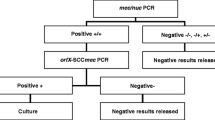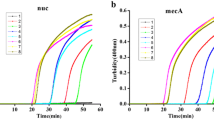Abstract
The aim of the present study was to determine the diagnostic value of a single-locus real-time polymerase chain reaction (PCR) recently proposed for rapid detection of methicillin-resistant Staphylococcus aureus (MRSA) from clinical samples (IDI-MRSA; Infectio Diagnostic, Sainte-Foy, Québec, Canada). This test, which was developed on the basis of studies of the sequence analysis of the mecA gene carried by staphylococcal cassette chromosome mec (SCCmec), was used to screen nasal swabs of 320 intensive care unit (ICU) patients at admission. The results were compared with those of conventional culture of swabs from several body sites. When compared with culture of swabs from the nose, throat, and wounds, the diagnostic values of the real-time PCR test from nasal swabs were as follows: 92.3% sensitivity, 98.6% specificity, 75.0% positive predictive value, and 99.6% negative predictive value. Fifteen (4.7%) samples could not be evaluated because the PCR reaction was inhibited, even after the samples were frozen and thawed for retesting. Culture of nasal swabs showed that 78 of the patients were colonized with methicillin-susceptible S. aureus. Unexpectedly, 4 (5.1%) of these samples gave false-positive results in the IDI-MRSA. These isolates were all single clones, as shown by pulsed-field gel electrophoresis and spa typing. Reliable results were obtained with the IDI-MRSA assay, even in a patient population with a low prevalence (approximately 4%) of MRSA and even when compared with swabs of different body sites. Nevertheless, further work is needed to reduce the inhibition rate of the PCR and to explain why false-positive results were obtained with methicillin-susceptible S. aureus.

Similar content being viewed by others
References
Kommission für Krankenhaushygiene und Infektionsprävention (1999) Empfehlung zur Prävention und Kontrolle von Methicillin-resistenten Staphylococcus aureus-Stämmen (MRSA) in Krankenhäusern und anderen medizinischen Einrichtungen. Bundesgesundheitsbl Gesundheitsforsch Gesundheitsschutz 42:954–958
Working Party Report (1998) Revised guidelines for the control of methicillin-resistant Staphylococcus aureus infection in hospitals. J Hosp Infection 39:253–290
Geha DJ, Uhl JR, Gustaferro A, Persing DH (1994) Multiplex PCR for identification of methicillin-resistant staphylococci in the clinical laboratory. J Clin Microbiol 32:1768–1772
Reischl R, Linde HJ, Metz M, Leppmeier B, Lehn N (2000) Rapid identification of methicillin-resistant Staphylococcus aureus and simultaneous species confirmation using real-time fluorescence PCR. J Clin Microbiol 38:2429–2433
Eigner U, Holfelder M, Wild U, Peters B, Fahr AM (2004) Direct detection of MRSA from clinical swabs with nucleic acid amplification assays. 56th Deutsche Gesellschaft für Hygiene und Mikrobiologie (DGHM) Congress, 2004, Münster (Germany), Abstract no. DVV09
Towner KJ, Talbot DC, Curran R, Webster CA, Humphreys H (1998) Development and evaluation of a PCR-based immunoassay for the rapid detection of methicillin-resistant Staphylococcus aureus. J Med Microbiol 47:607–613
Jonas D, Speck M, Daschner FD, Grundmann H (2002) Rapid PCR-based identification of methicillin-resistant Staphylococcus aureus from screening swabs. J Clin Microbiol 40:1821–1823
Fang H, Hedin G (2003) Rapid screening and identification of methicillin-resistant Staphylococcus aureus from clinical samples by selective-broth and real-time PCR assay. J Clin Microbiol 41:2894–2899
Francois P, Pittet D, Bento M, Pepea B, Vaudaux P, Lew D, Schrenzel J (2003) Rapid detection of methicillin-resistant Staphylococcus aureus directly from sterile or nonsterile clinical samples by a new molecular assay. J Clin Microbiol 41:254–260
Ito T, Katayama Y, Asada K, Mori N, Tsustumimoto K, Tiensasitorn C, Hiramatsu H (2001) Structural comparison of three types of staphylococcal cassette chromosome mec integrated in the chromosome in methicillin-resistant Staphylococcus aureus. Antimicrob Agents Chemother 45:1323–1336
Huletsky A, Giroux R, Rossbach V, Gagnon M, Vaillancourt M, Bernier M, Gagnon F, Truchon K, Bastien M, Picard FJ, van Belkum A, Ouellette M, Roy PH, Bergeron MG (2004) New real-time PCR assay for rapid detection of methicillin-resistant Staphylococcus aureus directly from specimens containing a mixture of staphylococci. J Clin Microbiol 42:1875–1884
Warren DK, Liao RS, Merz LR, Eveland M, Dunne WM Jr (2004) Detection of methicillin-resistant Staphylococcus aureus directly from nasal swab specimens by a real-time PCR assay. J Clin Microbiol 42:5578–5581
Clinical and Laboratory Standards Institute (2005) Performance standards for antimicrobial susceptibility testing. approved standard M100-S15. CLSI, Wayne, PA
Schmitz FJ, Mackenzie CR, Hofmann B, Verhoef J, Finken-Eigen M, Heinz HP, Kohrer K (1997) Specific information concerning taxonomy, pathogenicity and methicillin resistance of staphylococci obtained by a multiplex PCR. J Med Microbiol 46:773–778
Martineau F, Picard FJ, Roy PH, Ouellette M, Bergeron MG (1998) Species-specific and ubiquitous-DNA-based assays for rapid identification of Staphylococcus aureus. J Clin Microbiol 36:618–623
Wei MQ, Wang FU, Grubb WB (1992) Use of contour-clamped homogenous electric field electrophoresis to type methicillin-resistant Staphylococcus aureus. J Med Microbiol 36:172–176
Murchan S, Kaufmann ME, Deplano A, de Ryck R, Struelens M, Zinn CE, Fussing V, Salmenlinna S, Voupio-Varkila J, El Solh N, Cuny C et al (2003) Harmonization of pulsed-field gel electrophoresis protocols for epidemiological typing of strains of methicillin-resistant Staphylococcus aureus: a single approach developed by consensus in 10 European laboratories and its application for tracing the spread of related strains. J Clin Microbiol 41:1574–1585
Tenover F, Arbeit R, Goering R, Mickelsen P, Murray B, Persing D, Swaminathan B (1995) Interpreting chromosomal DNA restriction patterns produced by pulsed-field gel electrophoresis: criteria for bacterial strain typing. J Clin Microbiol 33:2233–2239
Harmsen D, Claus H, Witte W, Rothganger J, Claus H, Turnwald D, Vogel U (2003) Typing of methicillin-resistant Staphylococcus aureus in a university hospital setting by using novel software for spa repeat determination and database management. J Clin Microbiol 41:5442–5448
Shopsin B, Gomez M, Montgomery SO, Smith DH, Waddington M, Dodge DE, Bost DA, Riehman M, Naidich S, Kreiswirth BN (1999) Evaluation of protein A gene polymorphic region DNA sequencing for typing of Staphylococcus aureus strains. J Clin Microbiol 37:3556–3563
National Committee for Clinical Laboratory Standards (2000) Methods for dilution antimicrobial susceptibility tests for bacteria that grow aerobically. Approved standard M7-A5. NCCLS, Wayne, PA
Sanford MD, Widmer AF (1994) Efficient detection and long-term persistence of the carriage of methicillin-resistant Staphylococcus aureus. Clin Infect Dis 19:1123–1128
Girou E, Pujade G, Legrand P, Cizeau F, Brun-Buisson C (1998) Selective screening of carriers for control of methicillin-resistant Staphylococcus aureus (MRSA) in high-risk hospital areas with a high level of endemic MRSA. Clin Infect Dis 27:543–550
Blok HE, Vriens M (2001) Carriage of methicillin-resistant Staphylococcus aureus (MRSA) after discharge from hospital: follow-up for how long? A Dutch multi-centre study. J Hosp Infect 48:325—327
Coello R, Juminez J, Garcia M, Arroyo P, Minguez D, Fernandez C, Cruzet F, Gaspar C (1994) Prospective study of infection, colonization and carriage of methicillin-resistant Staphylococcus aureus in an outbreak affecting 990 patients. Eur J Clin Microbiol Infect Dis 13:74–81
Kommission für Krankenhaushygiene und Infektionsprävention (2004) Kommentar zu den “Empfehlungen zur Prävention und Kontrolle von Methicillin-resistenten Staphylococcus aureus-Stämmen in Krankenhäusern und anderen medizinischen Einrichtungen”. Epidemiol Bull 46:396
Robert Koch-Institut (RKI) (2005) Fachtagung der AG Nosokomiale Infektionen am RKI zur Intensivierung der Umsetzung von Präventionsstrategien bei MRSA. Epidemiol Bull 47:31–42
Becker K, Pagnier I, Schuhen B, Wenzelburger F, Friedrich AW, Kipp F, Peters G, von Eiff C (2006) Does nasal cocolonization by methicillin-resistant coagulase-negative staphylococci and methicillin-susceptible Staphylococcus aureus strain occur frequently enough to represent a risk of false-positive methicillin-resistant S. aureus determinations by molecular methods? J Clin Microbiol 44:229–231
Papia G, Louie M, Tralla A, Johnson C, Collins V, Simor AE (1999) Screening high-risk patients for methicillin-resistant Staphylococcus aureus on admission to the hospital: is it cost effective? Infect Control Hosp Epidemiol 20:473–477
Acknowledgements
Tina Saveedra is gratefully acknowledged for her help with the English translation. We thank Sabine Petersdorf, Institute for Hygiene, University of Heidelberg, for PFGE typing results of the MRSA collection.
Author information
Authors and Affiliations
Corresponding author
Additional information
This study was presented in part at the 6th Symposium Krankenhausinfektionen, Ulm, Germany, March 2005.
Rights and permissions
About this article
Cite this article
Oberdorfer, K., Pohl, S., Frey, M. et al. Evaluation of a single-locus real-time polymerase chain reaction as a screening test for specific detection of methicillin-resistant Staphylococcus aureus in ICU patients. Eur J Clin Microbiol Infect Dis 25, 657–663 (2006). https://doi.org/10.1007/s10096-006-0203-2
Published:
Issue Date:
DOI: https://doi.org/10.1007/s10096-006-0203-2




